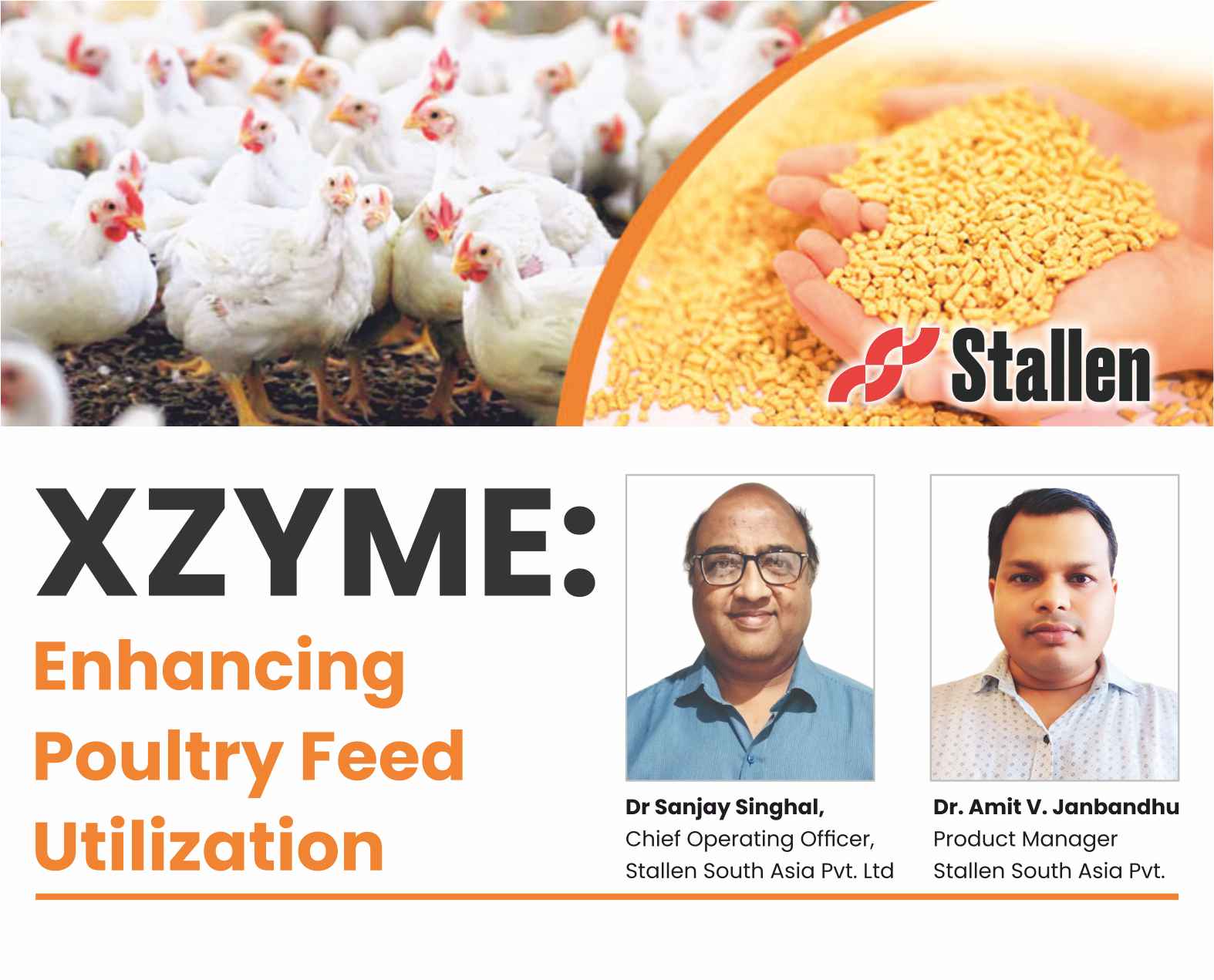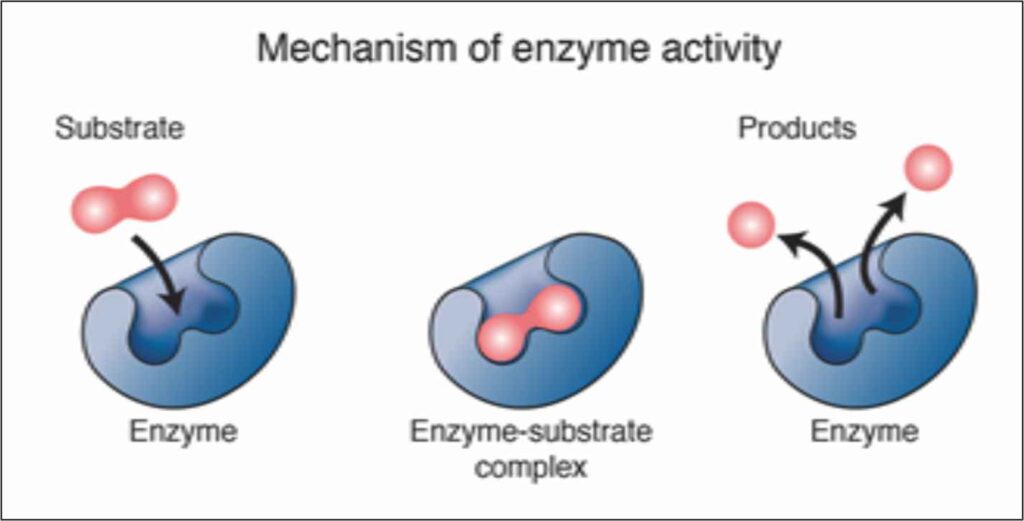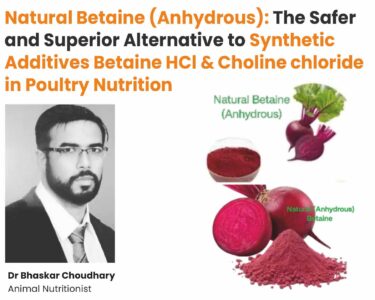
1. Introduction
Feeding enzymes to poultry is one of the major nutritional advances in the last fifty years. It is the culmination of something that nutritionists realized for a long time but until 1980’s it remained beyond their reach. Indeed, the theory of feed enzymes is simple. Plants contain some compounds that either the animal cannot digest, or which hinder its digestive system, often because the animal cannot produce the necessary enzyme to degrade them. Nutritionists can help the animal by identifying these indigestible compounds and feeding a suitable enzyme. These enzymes come from microorganisms that are carefully selected for the task and grown under controlled conditions (Wallis, 1996).
The biggest single expense in any system of poultry production is feed accounting for up to 70% of total production cost per bird. Poultry naturally produces enzymes to aid the digestion of feed nutrients. However, they do not have enzyme to break down fiber completely and need exogenous enzymes in feed to aid digestion. Plants contain some compounds that either the animal cannot digest, or which hinder its digestive system, often because the animal cannot produce the necessary enzyme to degrade them. Nutritionists can help the animal by identifying these indigestible compounds and feeding suitable enzyme. These enzymes come from microorganisms that are carefully selected for the task and grown under controlled conditions. (Creswell, 1994)
Anti-nutritional factors are problematic for normal feed digestion, results in low meat and egg production causes low feed efficiency and digestive upsets. Feed enzymes work to make the nutrient (starch, protein, amino acids and minerals, etc.) available from the feed ingredients. Feed enzymes also help to reduce the negative impact of animal production over environment by reducing the animal waste production. These Enzymes are proteins that are ultimately digested or excreted by the animal, leaving no residues in meat or eggs (Greiner and Konietzny, 2006).
The poultry industry readily accepts enzymes as a standard dietary component, especially in wheat and barley-based rations. But still many questions are partially answered. For example, how do enzymes work? Do growth rates reflect differences in the potency of different enzyme preparations? What is the link between gut viscosity, enzyme action and growth rates? and are enzymes necessary in all poultry rations? (Annison & Choct,1991).
2. Enzyme Supplementation in Poultry Ration
2.1. Enzyme
Enzymes are biological catalyst composed of amino acids with vitamins and minerals. They bring about biochemical reactions without themselves undergoing any change. They are involved in all anabolic and catabolic pathways of digestion and metabolism. Enzymes tend to be very specific catalysts that act on one or, at most, a limited group of compounds known as substrates. Enzymes are not living organisms and are not concerned about viability or cross infection. They are stable at 80-85 degree centigrade for short time. The benefits of using enzymes in poultry diets include not only enhanced bird performance and feed conversion but also less environmental problems due to reduced output of excreta. In addition, enzymes are a very useful tool in the study of physiological and metabolic mechanisms (Panda et al 2011).
2.2. Enzymes in Poultry Nutrition: The use of enzymes in animal feed is of great importance. Consistent increase in the price of feed ingredients has been a major constraint in most of the developing countries. As a consequence, cheaper and non-conventional feed ingredients have to be used which contain higher percentage of Non-Starch Polysaccharides (soluble and insoluble/crude fibre) along with starch. Non Starch Polysaccharides (NSPs) are polymeric carbohydrates which differ in composition and structure from starch (Morgan et al., 1995) and possess chemical cross linking among them therefore, are not well digested by poultry. A part of these NSPs is water-soluble which is notorious for forming a gel like viscous consistency in the intestinal tract (Ward et.al,1995) thus by reducing gut performance.
Poultry do not produce enzymes for the hydrolysis of Non-Starch Polysaccharide present in the cell wall of the grains and they remain un-hydrolysed. This results in low feed efficiency. Research work has suggested that the negative effects of NSPs can be overcome by dietary modifications including supplementation of diets with suitable exogenous enzyme preparations (Creswell, 1994). Enzymes break down the NSPs, decreases intestinal viscosity and eventually improve the digestibility of nutrients by improving gut performance.
Stallen South Asia Pvt Ltd has developed XZYME, a multi-enzyme formulation designed to optimize poultry feed utilization comprehensively. This innovative product combines various enzymes strategically selected to address specific nutritional challenges in poultry diets.

a) Cellulase
Cellulase is an enzyme complex that breaks down cellulose, a polysaccharide found in the cell walls of plants. Cellulose is composed of long chains of glucose molecules linked together by β-1,4-glycosidic bonds, making it a tough and fibrous substance that many animals, including poultry, cannot digest on their own. Cellulase enzymes help in hydrolyzing these bonds, converting cellulose into simpler, more digestible sugars.
b) Xylanase
Xylanase is an enzyme that hydrolyzes xylan into xylose, a simpler sugar. Xylan is a type of hemicellulose, which, like cellulose, is a polysaccharide present in plant cell walls. Xylanase breaks the β-1,4-glycosidic bonds in xylan, making it easier for poultry to digest plant-based feed ingredients.
c) β-Glucanase
β-Glucanase is an enzyme that plays a significant role in poultry nutrition by breaking down β-glucans, which are complex polysaccharides found in the cell walls of cereals such as barley, oats, and wheat. β-glucans are glucose polymers linked primarily by β-1,3 and β-1,4 glycosidic bonds. These β-glucans can be problematic in poultry diets because they increase the viscosity of the intestinal contents, hindering nutrient absorption and overall digestion. Here’s an overview of β-glucanase and its benefits in poultry nutrition.
d) Phytase
Phytase is an enzyme that catalyzes the hydrolysis of phytic acid (myo-inositol hexakisphosphate), a form of phosphorus that is commonly found in plant seeds and grains. Phytic acid binds phosphorus in a form that is not readily available to poultry because they lack sufficient endogenous phytase activity to break down this compound.
Phytase hydrolyzes phytic acid through a stepwise removal of phosphate groups, resulting in the release of inorganic phosphorus and lower inositol phosphates. This process occurs primarily in the stomach and upper small intestine of poultry, where the pH conditions are favorable for phytase activity.
e) Alpha-Amylase
Amylase acts on the α-1,4-glycosidic bonds within the starch molecule. Alpha-amylase randomly cleaves these bonds along the starch chain, resulting in the production of smaller carbohydrate molecules like maltose, dextrins, and glucose. These simpler sugars are then readily absorbed in the small intestine and utilized for energy.
f) Pectinase
Pectinase is an enzyme that catalyzes the hydrolysis of pectin, a structural polysaccharide in the cell walls of plants, particularly in fruits and vegetables. Pectin consists of a complex set of polysaccharides rich in galacturonic acid. Pectinases include a group of enzymes such as polygalacturonase, pectin lyase, and pectinesterase that break down pectin into simpler molecules like galacturonic acid, arabinose, and methanol which can be more readily absorbed by the poultry’s digestive system.
g) Protease
Protease is a type of enzyme that catalyzes the hydrolysis of peptide bonds within proteins, converting them into smaller peptides and free amino acids. These simpler molecules are more easily absorbed and utilized by the poultry for various physiological functions.
h) Lipase
Lipase enzymes work by hydrolyzing the ester bonds within triglycerides, breaking them down into free fatty acids and glycerol. This process primarily occurs in the small intestine, where lipase from the pancreas mixes with dietary fats, facilitating their breakdown and subsequent absorption by the intestinal cells.
3. Benefits of XZYME:
Benefits of using feed enzymes to poultry diets include; reduction in digesta viscosity, enhanced digestion and absorption of nutrients especially fat and protein, improved Apparent Metabolizable Energy (AME) value of the diet, increased feed intake, weight gain, and feed–gain ratio, reduced beak impaction and vent plugging, decreased size of gastrointestinal tract, altered population of microorganisms in gastrointestinal tract, reduced water intake, reduced water content of excreta, reduced production of ammonia from excreta, reduced output of excreta, including reduced N and P (Campbell et al. 1989).
a) Reduction in Digesta Viscosity: (Morgan et al,1995) found that that enzyme supplementation of wheat-based diets significantly reduced foregut digesta viscosity of birds. The reduction in foregut digesta viscosity was achieved primarily by reducing the molecular weight through hydrolysis of xylan backbone by endo-xylanase into smaller compounds and thus reduction in viscous effects of the feed because foregut digesta viscosity is directly proportional to the molecular weight of wheat arabinoxylans (Bedford and Classen, 1993).
b) Increase in Available Energy: One of the main reasons for supplementing wheat- and barley-based poultry diets with enzymes is to increase the available energy content of the diet. Increased availability of carbohydrates for energy utilization is associated with increased energy digestibility (Partridge and Wyatt ,1995). The AME of wheat has been extensively studied and found to have a considerable range i.e 9500–16640 kJ/kg (Mollah et al. 1983). Enzyme supplementation improves this range by enhancing carbohydrate digestibility, reducing gut viscosity, and improving fat utilization (Almirall et al. 1995).
c) Improvement in Nutrient Digestibility: Enzymes have been shown to improve performance and nutrient digestibility when added to poultry diets containing cereals, such as barley and wheat (Fengler et al. 1988).
d) Health improvement: Morgan and Bedford (1995) reported that coccidiosis problems could be prevented by using enzymes. Birds fed a wheat-based diet with and without glycanase supplementation showed vastly different responses to coccidiosis challenge. Growth was depressed by 52.5% in the control group but by only 30.5% in the enzyme group, which also had a much better lesion score. An increase in digesta passage rate and a reduction in excreta moisture are often noted when glycanases are added to poultry diets, which may be detrimental to the life cycle of the organism.
e) Impact on Environment: Enzymes have been approved for use in poultry feed because they are natural products of fermentation and therefore pose no threat to the animal or the consumer. Enzymes not only will enable livestock and poultry producers to economically use new feedstuffs, but will also prove to be environmentally friendly, as they reduce the pollution associated with animal production. As well as contributing to improved poultry production, feed enzymes can have a positive impact on the environment. In areas with intensive poultry production, the phosphorus output is often very high, resulting in environmental problems such as eutrophication.
This happens because most of the phosphorus contained in typical feedstuffs exists as the plant storage form phytate, which is indigestible for poultry. The phytase enzyme frees the phosphorus in feedstuffs and also achieves the release of other minerals (e.g. Ca, Mg), as well as proteins and amino acids bound to phytate. Thus, by releasing bound phosphorus in feed ingredients, phytase reduces the quantity of inorganic phosphorus needed in diets, makes more phosphorus available for the bird, and decreases the amount excreted into the environment.
Conclusion:
XZYME represents a significant advancement in poultry nutrition, offering a tailored solution to maximize feed efficiency and optimize poultry health. With its comprehensive enzyme blend and proven effectiveness, XZYME supports sustainable and profitable poultry production practices.
References:
Almirall, M., M. Francesch, A. M. Perez-Venderell, J. Brufau, and E. Esteve-Garcia. (1995). The differences in intestinal viscosity produced by barley and ß-glucanase alter digesta enzyme activities and ileal nutrient digestibilities more in broiler chicks than in cocks. Journal of Nutrition 125: 947–955.
Annison, G. and M. Choct. (1991). Anti-nutritive activities of cereal non-starch polysaccharides in broiler diets and strategies for minimizing their effects. World’s Poultry Science Journal 47: 232–242.
Bedford, M.R. and H. L. Classen. (1993). An in-vitro assay for prediction of broiler intestinal viscosity and growth when fed rye-based diets in the presence of exogenous enzymes. Poultry Science 72: 137-143.
Campbell, G.L., B. G. Rossnagel., H. L. Classen and P. A. Thacker. (1989). Genotypic and environmental differences in extract viscosity of barley and their relationship to its nutritive value for broiler chickens. Animal Feed Science and Technology 226: 221–230.
Creswell, D.C. (1994). Upgrading the nutritional value of grains with the use of enzymes. Technical bulletin, American Soybean Association, 341 Orchard Road No.11-03 Liat Towers, Singapore.
Fengler, A.I. and R. R. Marquardt. (1988). Water-soluble pentosans from rye. II. Effects on the rate of dialysis and on the retention of nutrients by the chick. Cereal Chemistry 65: 298–302.
Greiner, R., Konietzny, U., 2006. Phytase for food applications. Food Technol. Biotechnol., 44(2): 125-140.
Mollah, Y., Bryden, W.L., Wallis, I.R., D. Balnave and E. F. Annison. (1983). Studies on low metabolisable energy wheats for poultry using conventional and rapid assay procedures and the effects of processing. British Poultry Science 24: 81–89.
Morgan, A.J. and M. R. Bedford. (1995). Advances in the development and application of feed enzymes. Australian Poultry Science Symposium 7: 109–115.
Panda A.K., S. V. Rama Rao, M. V. L. N. Raju, M. R. Reddy and N. K. Praharaj. 2011. The Role of Feed Enzymes in Poultry Nutrition.
Partridge, G. and C. Wyatt (1995). More flexibility with new generation of enzymes. World Poultry 11(4), 17–21.
Wallis, I. (1996). Enzymes in poultry Nutrition. Technical Note, SAC.West Mains road, Edinburgh.
Ward, N.E. (1995). With dietary modifications, wheat can be used for poultry. Feedstuffs 7 Aug, 14-16.





